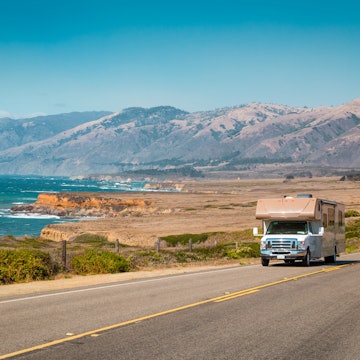

Tourists posing in front of the Facebook sign in Silicon Valley
With the third-largest population in California, and sprawling suburbs that spill into other South Bay cities, San Jose covers a vast area. Traveling outside the center can feel a bit like navigating a vast 3D maze. San Jose is well connected to the rest of the Bay Area though, and connections are only going to get better with the extension of the Bay Area Rapid Transit (BART) network into Silicon Valley.
Like many West Coast cities, San Jose relies heavily on freeways and car-centric city planning, but, on a par with the rest of the Bay Area, it has a stellar public transportation system and plenty of app-based rideshare options for those who’d rather not get behind the wheel.
Here are the best ways to get around San Jose so you can fully embrace all the city has to offer.
Transport passes
Valley Transportation Authority (VTA) operates the integrated transportation system in San Jose, and they provide real-time information about fares and schedules, especially through their app. All inner-city transportation in San Jose charges a flat fee and children under 5 ride free with an adult. You can purchase single tickets, day passes and monthly passes from ticket vending machines at light rail stations, or use the prepaid, rechargeable Clipper Card.
On buses and light rail services, you can pay with cash, but you’ll need to have the exact amount ready since they don’t give change. Fareboxes accept coins up to $1 and bills in $1, $5, $10 and $20 increments. It's easier to use the Clipper Card, which can be purchased at light rail, BART, or Caltrain stations, or from Walgreens or the VTA Downtown Customer Service Center.
You can also request a card to be sent to you through their website, or sign up for a virtual card that operates through the Clipper app. Just charge the card with credit and “tap on” every time you ride; you don’t need to tap off unless you’re riding BART or Caltrain trains, where the fare is calculated based on the distance traveled.
Bus
San Jose’s public buses are operated by the Valley Transportation Authority and services cover a wide portion of the city and the greater Santa Clara Valley. Buses are comfortable, air-conditioned and come often and mostly on time. Since 2018, the VTA has started introducing fully electric buses to meet California’s goal of zero-emission bus transport by 2040. Single bus rides cost $2.50 and day passes are $7.50.

Light rail
An easy alternative to riding San Jose's buses, which can be slow during heavy traffic, is taking one of the three light rail lines that crisscross the city. VTA's light rail trains serve 52 stations in Santa Clara County, covering more than 42 miles of tracks. The green and blue lines connect to downtown and take riders south, north and west to other cities. The orange line travels east to west on the outskirts of San Jose. The light rail also connects to BART, Caltrain and Greyhound stations – handy if you're planning to roam further afield.
Bicycle
Despite seeing floods of traffic on a daily basis, San Jose is surprisingly bike-friendly. With year-round moderate weather and flat, wide streets, this is ideal cycling territory, and it’s easy and safe to use the city’s 400 miles of bike lanes to get around town. Some bike shops offer rentals, but it's simpler to use San Jose's bike-sharing scheme, Bay Wheels, which can be booked via the Lyft app. You'll find conventional bikes and e-bikes at docking stations all over the city; rides start at $3 and cost $0.30 per minute after that.
E-Scooter and E-Moped
San Jose is all about micromobility these days, which explains the huge number of electric scooters and mopeds you'll see left haphazardly on sidewalks around downtown. Lime Scooters has the largest fleet of e-scooters in San Jose and they now offer e-mopeds as well. Both scooters and mopeds can be unlocked through the Lime app, and cost $1 to unlock plus $0.29 per minute and $0.39 per minute, respectively.

Rideshares
San Jose is located just down the highway from where Uber and Lyft first started operating in San Francisco. Both apps have been popular in San Jose since 2013 and are probably the most popular way to take short trips around the city. However, Uber and Lyft’s prices have gone up substantially since the pandemic started and it's no longer possible to save money by carpooling with other users. Expect to pay closer to what you might pay for a conventional taxi, or potentially even more during times of surge pricing.
Taxi
Since the introduction of ridesharing into San Jose's transportation pool, old-fashioned taxis have somewhat fallen out of favor. You’ll still find them at the airport and around busier parts of the city, but they’re not as ubiquitous as they once were. Because of this, it’s best to give them a call or use the Curb app instead of expecting to be able to flag one down.
Yellow Cab and Checker Cab share bookings and can arrange accessible vehicles for travelers with mobility issues. Taxi prices start at around $3.50 with $3.00 added on for each mile. It’s expected to tip around 15% for a standard ride.
Walking
At 181 sq miles, San Jose isn’t exactly a walkable city but it is pedestrian-friendly. Within individual neighborhoods and downtown, you’ll find wide sidewalks, plenty of crosswalks and leafy streets that offer some shade from the sun. Walking can be the best way to get around within a neighborhood or a smaller section of the city, and it's rarely cold enough to require a heavy coat, even in winter.

Car
There always seems to be traffic in San Jose at any time of day, and parking can be a pain in the city center, but a car is still the quickest way to get around the city. All of the usual national car rental chains are represented at San Jose International Airport, and there are also less traditional options such as Turo, which allows you to rent cars inexpensively directly from owners.
If you don’t need a car for the whole day, there are a variety of hourly car-share options as well, including Zipcar and Getaround. These are generally cost-effective if you only need a car for a few hours, but rates mount up quickly the longer you rent for.
Accessible transportation in San Jose
California is celebrated worldwide for its commendable focus on accessible public transportation, and San Jose is no exception. All buses and light rail trains and stations have ramps, auditory signals and other accessible features to accommodate passengers in wheelchairs and the visually impaired.
Streets and sidewalks are highly accessible throughout San Jose, with plenty of drop-down curbs and crosswalks that use auditory signals. Uber and Lyft both offer wheelchair-accessible rides (called WAV) through their respective apps and most taxi companies can accommodate foldable wheelchairs if you call ahead. For more information, see Lonely Planet's accessible travel resources.
You may also like:
Smell all the roses and other insta-worthy free things to do in San Jose, California
The best things to do in San Jose, California include roller coasters and testing the world's top tech
Top reasons to visit San Jose in the fall (and other great times to come)
















